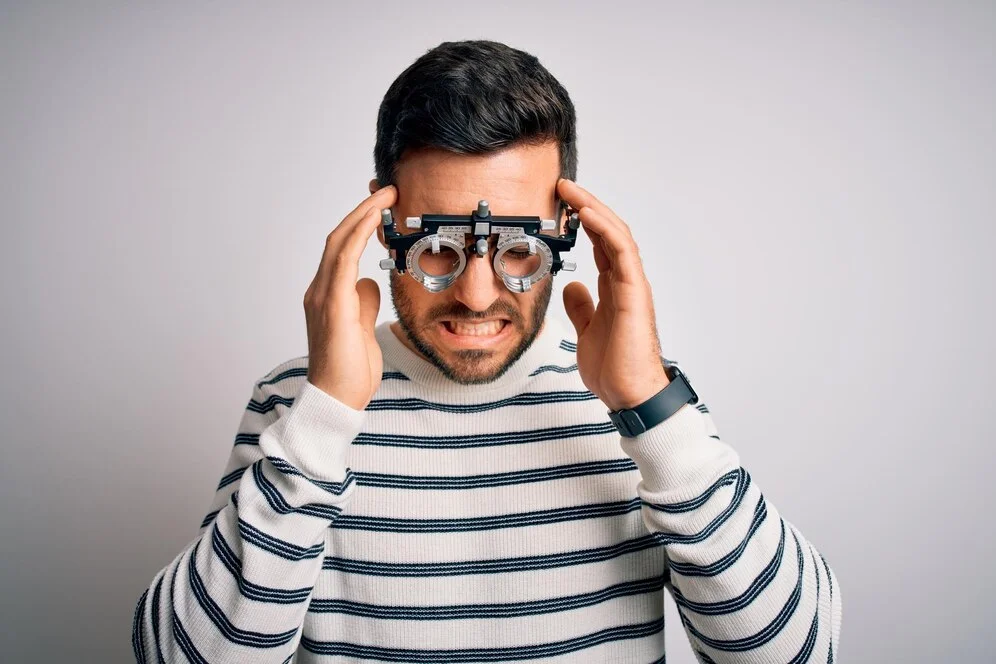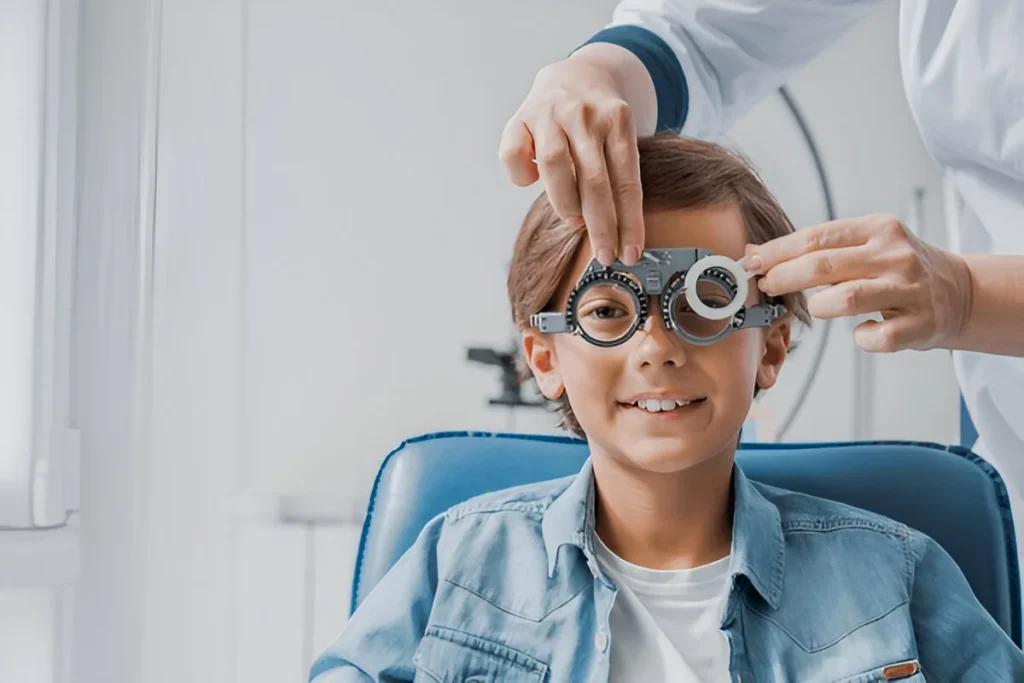Early signs of myopia can be subtle but are crucial to detect. Learn how a reputed eye surgeon recommends identifying and addressing these signs to protect your child’s vision.
Myopia, commonly known as nearsightedness, is one of the most common refractive errors in children and adults. However, parents need to be vigilant during their child’s formative years. Early detection of myopia can prevent the condition from worsening and help to protect the child’s long-term vision.
Parents can play a crucial role in identifying the early signs of myopia, ensuring that their child gets the right care and intervention as early as possible. This article discusses these early signs in detail and offers valuable tips for parents on how to manage the condition effectively. By spotting these signs early, parents can help their children avoid more serious complications in the future.

What is Myopia?
Myopia occurs when light entering the eye is not focused directly on the retina, which is responsible for transmitting images to the brain. This causes distant objects to appear blurry, while close objects remain clear. It is primarily caused by the elongation of the eyeball or an overly curved cornea. Myopia can develop at a young age, and in many cases, the condition progresses until the late teens or early adulthood.
Though myopia can be easily corrected with glasses or contact lenses, the condition, if left unchecked, can lead to serious eye health issues, including retinal detachment, cataracts, or glaucoma. For this reason, it is essential to identify the signs early on.
Early Signs of Myopia Parents Should Watch For
When it comes to myopia in children, parents are often the first line of defense. Recognizing the early signs of myopia can ensure timely intervention and prevent the condition from worsening. Below are the most common signs that your child might be experiencing difficulty with distance vision:
1. Squinting to See Faraway Objects
Squinting is one of the most noticeable behaviors in children with myopia. Children who have difficulty seeing distant objects may squint or narrow their eyes to try to bring things into focus. If you notice your child squinting while watching TV, during a class presentation, or while trying to read distant signs, it may be a sign of myopia.
2. Sitting Too Close to the TV or Computer Screen
Myopic children may sit unusually close to the television, computer screen, or other devices because they cannot clearly see objects at a distance. If you find your child consistently sitting close to screens, it’s time to have their vision checked.
3. Frequent Complaints of Headaches
Headaches, especially after prolonged activities like reading or focusing on distant objects, are another common symptom of myopia. The strain on the eyes from trying to see clearly can lead to tension headaches. If your child complains of headaches, particularly after tasks that require focusing, it could be a sign of myopia.
4. Difficulty Seeing the Whiteboard in Class
Teachers often notice that children with undiagnosed myopia struggle to see the whiteboard from a distance. If your child is frequently asking you to help them with homework because they can’t see the board properly, it might indicate the need for an eye exam.
5. Frequent Eye Rubbing or Blinking
Children with myopia might rub their eyes or blink frequently as they attempt to focus better on distant objects. This behavior can be a sign that their eyes are straining to make sense of blurry images.
6. Avoiding Distance Activities
Children with myopia may avoid participating in activities that require clear distance vision, such as sports or even outdoor games. This avoidance is a common indicator that the child is struggling to see distant objects.

Risk Factors for Myopia
Some children are at a higher risk for developing myopia due to a combination of genetic and environmental factors. Understanding these risk factors can help parents monitor their child’s vision and act earlier.
1. Genetic Predisposition
If one or both parents have myopia, the child is more likely to develop the condition as well. Research shows that children with myopic parents are at a significantly higher risk of developing myopia themselves.
2. Prolonged Near Work
Engaging in activities like reading, writing, and using electronic devices for long periods can increase the risk of developing myopia. Children who spend a lot of time focused on near tasks without taking breaks may experience eye strain, which can lead to the development of myopia.
3. Limited Outdoor Time
Studies have shown that children who spend more time outdoors are less likely to develop myopia. Exposure to natural light is thought to play a role in the proper development of the eyes. Conversely, children who spend a lot of time indoors, especially on screen devices, may be at greater risk.
How to Protect Your Child’s Vision
While myopia cannot always be prevented, there are several ways to reduce its progression or at least mitigate its effects. The following tips can help protect your child’s vision:
1. Encourage Regular Outdoor Play
Encouraging your child to spend more time outdoors can significantly reduce their risk of developing myopia. Aim for at least two hours of outdoor activity each day to help maintain healthy eye development. Natural sunlight is beneficial for eye health.
2. Adopt the 20-20-20 Rule
If your child engages in prolonged near tasks, such as reading or using a computer, remind them to follow the 20-20-20 rule. Every 20 minutes, they should take a 20-second break by looking at something 20 feet away. This will help alleviate eye strain and prevent myopia from progressing.
3. Limit Screen Time
Excessive screen time has been linked to myopia development in children. Limiting your child’s screen time and ensuring they take regular breaks can help protect their eyes from strain and reduce their risk of developing myopia.
4. Ensure Proper Lighting
Good lighting is essential for any near work, such as reading or studying. Make sure that your child’s study or reading area is well-lit to minimize strain on their eyes.
5. Regular Eye Exams
The most effective way to detect myopia early is by scheduling regular eye exams. Children should have their eyes checked at least once a year or as recommended by an eye care professional. Early detection allows for quicker intervention, such as glasses or contact lenses, to manage the condition.
When to Consult an Eye Care Professional
If your child shows any of the early signs of myopia, it is important to seek professional help from an eye care provider. The best way to manage myopia is through regular eye exams and early intervention. An eye doctor may recommend prescription glasses, contact lenses, or even specialized treatments like orthokeratology or atropine drops to slow myopia progression.

Frequently Asked Questions (FAQs)
Q1: What are the most common signs of myopia in children?
Common signs include squinting, sitting too close to screens, frequent headaches, difficulty seeing distant objects, and avoiding distance activities.
Q2: At what age does myopia typically develop?
Myopia usually develops in children between the ages of 6 and 14. However, it can start as early as 3 years old.
Q3: Can myopia be corrected?
Yes, myopia can be corrected with glasses, contact lenses, or even surgery in some cases. Early correction is key to preventing further progression.
Q4: How can I prevent my child’s myopia from getting worse?
Encouraging outdoor activities, limiting screen time, following the 20-20-20 rule, and scheduling regular eye exams can help slow down the progression of myopia.
Q5: Can myopia be cured?
Currently, there is no cure for myopia, but it can be effectively managed and corrected with glasses, contacts, or other treatments.
Detect Myopia Early for Better Eye Health
Recognizing the early signs of myopia in children is crucial for preventing further eye health complications. By being vigilant and proactive, parents can help their children maintain clear vision and reduce the risk of myopia progression. Regular eye exams, outdoor activities, and lifestyle changes are essential steps to ensure long-term eye health.
If you notice any of the signs of myopia in your child, consult with an eye care professional to get proper guidance and treatment. Early intervention is key to preserving your child’s vision and overall eye health for the future.

